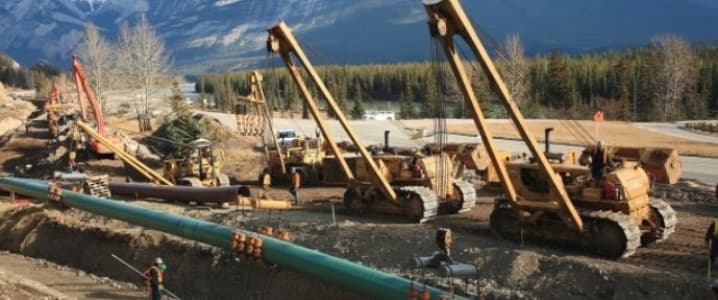Incoming President Donald Trump might quickly move to resolve the massive problem that Energy Transfer Partners has on its hands in the Dakota Access Pipeline, but the company is in the midst of stumbling into another potential controversy that could turn into the sequel to the Keystone XL and Dakota Access sagas.
The Bakken is a substantial source of crude oil, producing just under 1 million barrels per day. That oil has to be moved by rail or pipeline out of the state, where it moves to refineries either on the Eastern seaboard, or down to the Gulf Coast. But the extreme distances that North Dakota crude has to travel inevitably lead to conflict as pipelines run into local communities.
That potential for conflict became very stark with the Standing Rock Sioux Tribe in North Dakota. President Trump has suggested that the Army Corps of Engineers, under his control, will move quickly to approve the pipeline, although protestors will surely do their best to stop construction. If Trump is successful, Energy Transfer Partners will be relieved to put that controversy behind it.
But the story isn’t over there. Upon completion, the Dakota Access Pipeline will allow North Dakota oil to reach Illinois. From there it will tie into existing pipelines that will allow the oil to flow down to Texas and then on to Louisiana. But at that point, the path forward gets rocky again, and this is where Energy Transfer Partners could run headlong into its next brawl with local communities.
Energy Transfer Partners, along with joint owners Phillips 66 Partners and Sunoco Logistics Partners L.P., are proposing the Bayou Bridge Pipeline (BBP), a 163-mile pipeline that will run from Lake Charles, Louisiana to a key oil hub just west of New Orleans in St. James Parish. The oil will end at a terminal owned by NuStar Energy L.P., from which the oil could reach any number of customers, such as refiners along the Gulf Coast or be sent abroad as exports.
In other words, if the Dakota Access Pipeline is completed, the Bayou Bridge Pipeline will be the last key link connecting a greater volume of North Dakota oil to international markets. The BBP will carry 280,000 barrels of oil per day, with the potential to expand up to 480,000 bpd. Construction is slated to reach completion by the second half of 2017. Related: OPEC Production Cuts: Here’s The Cheat Sheet
The problem with the Bayou Bridge Pipeline is that it runs across the Atchafalaya Basin, a national heritage area that also happens to be the world’s largest natural swamp. It is home to endangered wildlife and also has a successful crawfishing industry. The pipeline route through the world’s largest swamp will cross 600 acres of wetlands and 700 bodies of water, which provide drinking water to over 300,000 people.
Because of this, there are signs that a popular resistance akin to the Dakota Access protests is starting to emerge. At a packed public hearing on January 12, a raucous crowd filled with pipeline critics from disparate backgrounds spoke out against the project. The crowd jeered and hissed at former Louisiana Senator Mary Landrieu, who testified in favor of the Bayou Bridge Pipeline. She now lobbies on behalf of Energy Transfer Partners.
But Energy Transfer Partners notes that pipelines are much safer than the alternative of shipping crude by rail; rail shipments are 4.5 times more likely to suffer an accident compared to pipeline, a 2015 Fraser Institute study showed. And the Atchafalaya Basin is already home to a spider web of old pipelines, the industry argues. However, the damage done to Louisiana’s wetlands from decades of pipeline construction are exactly why local communities, particularly the state’s fishing industry, are opposed to the Bayou Bridge Pipeline.
This may seem like a local story, but so did the Dakota Access Pipeline until mid-2016. Protests that delay construction have a tendency of blowing up the issue into a national flashpoint.
Above and beyond the PR disaster that could await Energy Transfer Partners, real money is also on the line. Energy Transfer’s stock lost 20 percent between the summer of 2016 and just before the election, a period of time that saw protests turn violent, as well as action from the federal government that put a hold on construction. The company’s share price has regained some of those losses on the back of Trump’s victory, but it has not rebounded to the high point of $43/share reached before the protests made national headlines. In fact, Energy Transfer’s share price started to nosedive in September after it was embarrassed by national headlines of attack dogs released on protestors in North Dakota. Related: OPEC Commitments Push Iraq Towards Oil Export Deal With Kurds
Protest can be dismissed as mere sideshows, but they can have a concrete impact. When financial analysts warn investors to steer clear of companies like Energy Transfer Partners because of the political risk, the public backlash to large infrastructure projects should be taken seriously.
There are also broader implications for the oil and gas industry. Environmental groups have been battle-tested by the multi-year Keystone XL fight, having constructed an infrastructure around protesting, disruption and media relations. That was on display with the Dakota Access blitz, which ultimately spurred the Obama administration to block construction. The incoming Trump administration will likely make it easier for companies to obtain federal permits, but environmental protests are not going away.
Even as the protests in the frozen prairie of North Dakota could be in their final act, the spotlight could shift more than 1,000 miles to the south to the swampy wetlands of the bayou.
By Nick Cunningham of Oilprice.com
More Top Reads From Oilprice.com:
- Oil Prices Fall In Spite Of Bullish OPEC Data
- $25 Trillion Investment Needed To Meet Future Oil Demand
- How The Federal Reserve Will Shape Oil Markets In 2017

















